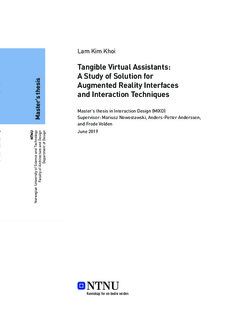Sammendrag
This research explores the combination of two technology - Augmented Reality (AR) and Virtual Assistant (VA). AR has been developed for several decades and has high potential of being applied in various industries such as commercial, education, entertainment, navigation, etc. However, AR contains limitations and restraints that prevent itself from becoming ubiquity. Those issues come from tracking technique, user interface, and interaction technique. This study focuses on the user interface problem and proposes virtual assistant as a solution. Virtual assistant has been employed widely and become more and more functional. Many technology giants apply VA to their products, such as Apple Siri, Google Assistant, Microsoft Cortana, Amazon Alexa, and so on. In this thesis, virtual assistant is hypothesized as an element that reduces information overload in AR user interface, increase the effectiveness of task performance, and enhance engagement between users and AR apps. Furthermore, VA is proposed to include appearance as a life-like character or animal; thus, it is named as Tangible Virtual Assistant.
Two prototypes of an AR app, one with graphics element only as a standard AR app and the other one with VA, are developed for the user study. Both quantitative and qualitative data are collected and analysed. The results show that the VA app significantly reduces information overload and increases the effectiveness in comparison with the Graphics app. Nevertheless, the hypothesis of enhancing engagement is not supported. This aspect requires further development and research.
